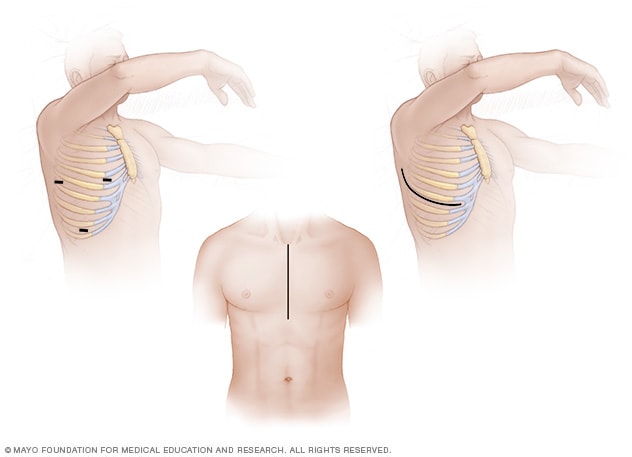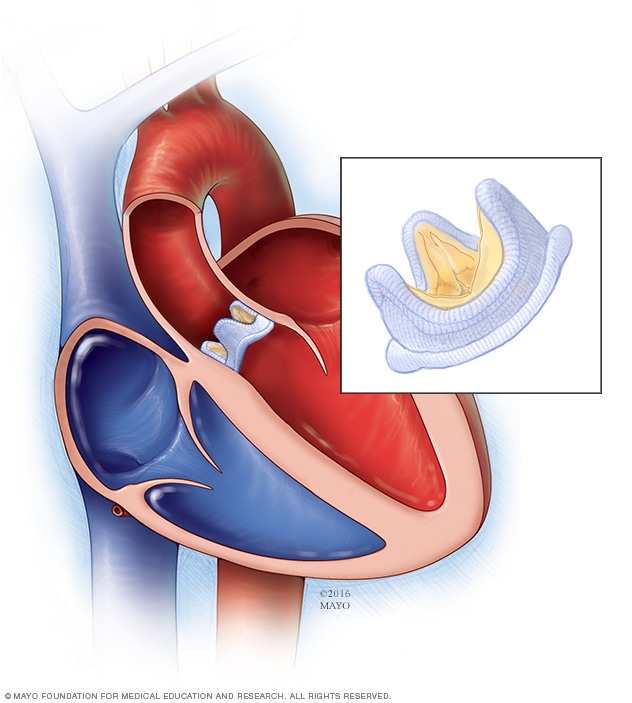Overview
Heart valve surgery is a procedure to treat heart valve disease. Heart valve disease happens when at least one of the four heart valves is not working properly. Heart valves keep blood flowing in the correct direction through the heart.
The four heart valves are the mitral valve, the tricuspid valve, the pulmonary valve and the aortic valve. Each valve has flaps — called leaflets for the mitral and tricuspid valves and cusps for the aortic and pulmonary valves. These flaps should open and close once during each heartbeat. Valves that don't open and close properly change blood flow through the heart to the body.
In heart valve surgery, a surgeon repairs or replaces the damaged or diseased heart valve or valves. Methods to do this may include open-heart surgery or minimally invasive heart surgery.
The type of heart valve surgery needed depends on age, overall health, and the type and severity of heart valve disease.
Robot-assisted heart valve surgery
Products & Services
Types
Why it's done
Heart valve surgery is done to treat heart valve disease. There are two basic types of heart valve disease:
- A narrowing of a valve, called stenosis.
- A leak in a valve that allows blood to flow backward, called regurgitation.
You might need heart valve surgery if you have heart valve disease that affects your heart's ability to pump blood.
If you don't have symptoms or if your condition is mild, your healthcare team might suggest regular health checkups. Lifestyle changes and medicines might help manage symptoms.
Sometimes, heart valve surgery may be done even if you don't have symptoms. For example, if you need heart surgery for another condition, surgeons might repair or replace a heart valve at the same time.
Ask your healthcare team whether heart valve surgery is right for you. Ask if minimally invasive heart surgery is an option. It does less damage to the body than does open-heart surgery. If you need heart valve surgery, choose a medical center that has done many heart valve surgeries that include both repair and replacement of the valve.
 Heart valve disease discussion at Mayo Clinic
Heart valve disease discussion at Mayo Clinic
A Mayo Clinic doctor discusses heart valve disease with a person.
Risks
Heart valve surgery risks include:
- Bleeding.
- Infection.
- Irregular heart rhythm, called arrhythmia.
- Problem with a replacement valve.
- Heart attack.
- Stroke.
- Death.
How you prepare
Your surgeon and treatment team discuss your heart valve surgery with you and answer any questions. Before you go to the hospital for heart valve surgery, talk with your family or loved ones about your hospital stay. Also discuss what help you'll need when you come home.
Food and medicines
Before you have heart valve surgery, talk to your care team about:
- Any medicines you regularly take and whether you can take them before your surgery.
- Allergies or reactions you've had to medicines.
- When you should stop eating or drinking the night before or the morning of the surgery.
Clothing and personal items
If you're having heart valve surgery, your treatment team might suggest that you bring certain items to the hospital, including:
- A list of your medicines.
- Eyeglasses, hearing aids or dentures.
- Personal care items, such as a brush, a comb, a shaving kit and a toothbrush.
- Loose, comfortable clothing.
- A copy of your advance directive. This is a legal document. It includes instructions about the kinds of treatments you want — or don't want — in case you become unable to express your wishes.
- Items that help you relax, such as portable music players or books.
During heart valve surgery, do not wear:
- Contact lenses.
- Dentures.
- Eyeglasses.
- Jewelry.
- Nail polish.
What you can expect
Before the procedure
You may need to have your body hair shaved where the surgical cuts, called incisions, are made. A special soap might be used to wash your skin to help prevent infection.
During the procedure
Incisions in minimally invasive heart surgery and open-heart surgery

Incisions in minimally invasive heart surgery and open-heart surgery
In minimally invasive heart surgery, surgeons access the heart through small cuts on the right side of the chest, as shown in the top two images. In open-heart surgery, surgeons make a larger incision in the midline of the chest, as shown in the bottom image.
You receive medicine called an anesthetic to put you in a sleep-like state during the procedure. You are connected to a heart-lung bypass machine, which keeps blood moving through the body during the surgery.
Heart valve surgery can be done using standard open-heart surgery. This involves making a surgical cut, called an incision, through the middle of the chest to reach the heart. Minimally invasive heart surgery involves much smaller incisions than those used in open-heart surgery. Minimally invasive surgery usually does not require cutting any significant muscle or breaking any bones.
Types of minimally invasive heart surgery include:
- Thoracoscopic surgery or mini-thoracotomy. A surgeon places long tools through one or more small incisions on the right side of the chest.
- Robot-assisted heart surgery. The surgery is done using the assistance of a robot.
Compared with open-heart surgery, minimally invasive heart surgery might involve:
- A shorter hospital stay.
- A quicker recovery.
- Less pain.
- Lower risk of infection.
- Less time spent in the intensive care unit.
- A lower risk of heart rhythm issues after surgery.
To get the best results, minimally invasive heart surgery ideally should be done at medical centers with medical teams experienced in doing these types of procedures.
Heart valve repair
Mitral valve repair

Mitral valve repair
In mitral valve repair, the surgeon removes and repairs part of the damaged mitral valve to allow the valve to fully close and stop leaking. The surgeon may tighten or reinforce the ring around a valve, called the annulus, by placing an artificial ring called an annuloplasty band.
Heart doctors recommend heart valve repair when possible. It saves the heart valve and avoids the need of a replacement heart valve. It also can help save heart function. During heart valve repair, a surgeon might:
- Patch holes in a valve.
- Reconstruct valve flaps, also called leaflets or cusps.
- Remove excess valve tissue so that the leaflets or cusps can close tightly.
- Replace or remove pieces of tissue called cords that are diseased and no longer support the valve.
- Separate valve flaps that have fused.
- Tighten or reinforce the ring around the valve, called the annulus.
Some heart valve repair procedures are done using a long, thin tube called a catheter and clips, plugs or other devices.
Doctors might treat a valve with a narrowed valve opening using a catheter procedure called balloon valvuloplasty. A catheter with a balloon on the tip is placed into an artery in the arm or groin. Then it is guided to the diseased or damaged valve.
The balloon is inflated, which widens the opening of the heart valve. Then it is deflated, and the catheter and balloon are removed.
Heart valve replacement
Biological valve replacement

Biological valve replacement
In a biological valve replacement, a valve made from cow, pig or human heart tissue replaces the damaged heart valve.
Mechanical valve replacement

Mechanical valve replacement
In a mechanical valve replacement, an artificial heart valve made of strong material replaces the damaged valve.
If your heart valve can't be repaired and other treatments aren't an option, the valve might need to be replaced. To replace a heart valve, a surgeon removes the heart valve and replaces it with a mechanical valve or a valve made from cow, pig or human heart tissue. Valves made from living tissue are called biological tissue valves.
Biological valves often need to be replaced eventually, as they tend to wear out over time. If you have a mechanical valve, you'll need to take blood-thinning medicines for life to prevent blood clots. Mechanical valves usually do not wear out over time. Your healthcare team likely will talk with you about the benefits and risks of each type of valve.
A minimally invasive catheter procedure might be used to replace certain heart valves. For example, a catheter procedure might be done to place a biological valve in the heart to replace a valve that is no longer working properly.
After the procedure
After your heart valve surgery, you usually spend a day or more in the hospital's intensive care unit. You get fluids and medicines through a needle in a vein, also called an IV. Other tubes drain urine from the bladder and fluid and blood from the chest. You might get oxygen through a mask or a small plastic tube next to your nose.
After you complete your stay in the ICU, you typically are moved to another hospital room for several days. How long you stay in the hospital depends on your condition and surgery.
After heart valve surgery, your care team does the following:
- Tracks your condition and watches for signs of infection.
- Checks your blood pressure, breathing and heart rate.
- Works with you to manage any pain you have after surgery.
You may be asked to walk regularly. This helps you slowly become more active. You are usually asked to cough and to do breathing exercises as you recover too.
You are given instructions to follow during your recovery, such as how to:
- Watch for symptoms of infection in your incisions.
- Take your medicines.
- Properly care for your incisions.
- Manage pain and other side effects after your surgery.
Results
After heart valve surgery, your doctor or another member of your healthcare team tells you when you can get back to your usual activities.
You need to go to regular follow-up appointments with your healthcare professional. You might have tests to check your heart health.
Lifestyle changes can keep your heart working well. Examples of heart-healthy lifestyle changes are:
- Eating a healthy diet.
- Getting regular exercise.
- Managing stress.
- Not smoking or using tobacco.
Your care team might suggest that you join a program of education and exercise called cardiac rehabilitation. It is designed to help you recover after heart surgery and improve your overall health and heart health.
Clinical trials
Explore Mayo Clinic studies of tests and procedures to help prevent, detect, treat or manage conditions.
Nov. 04, 2023